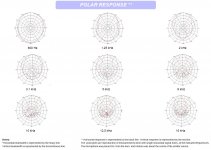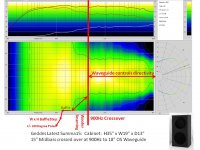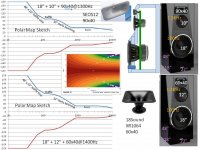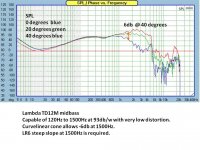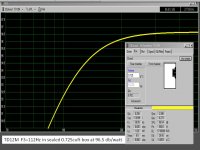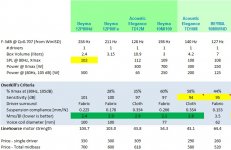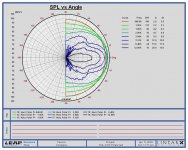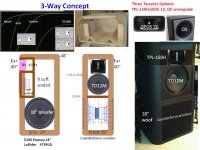Hello.
I while back I started a thread to help me design a bass section and received outstanding help. I'm hoping for good help here too
My aim is for a 4-way active stereo pair to be driven from a computer with Acourate software to do room correction, driver linearization, and digital crossover. That would feed a multichannel DAC, which in turn will drive amps directly, that in turn will drive the drivers directly.
As of now my design includes 12" subs to cover 20 to 80 (or 90 Hz). I already have a pair of DIY Rythmiks for this.
Midbass will be in a sealed box and will go from 80Hz up to 650/750Hz. I'm undecided about the driver, but shortlisted candidates are Acoustic Elegance TD10M or TD12M probably with Apollo motor upgrade, or Beyma 12P80Nd or 10MI100. I also got very good input about construction.
Now it's time to focus on tweeter and midrange. On the bass section thread I received a recommendation for TPL-150 and PHL 1660/1670. I've seen very, very good comments about the TPL-150 and not as many, but good comments about the 1660/1670.
What else should I consider?
How are Raals vs tPL-150? From my readings I got the sense one of the strengths of the TPL-150 is it can be crossed over low, somewhere around 1.5kHz. I believe in a 4-way I don't need this. Right? I was thinking of running the tweeter from 3 or 4kHz upwards, and hopefully get response above 20kHz as well. Mundorf AMTs? Or just stick with the TPL-150?
Regarding midrange, I guess I want to run from 650/750Hz up to 3/4kHz, despite the midbass drivers being able to go easily up to 1kHz. Accutons come to mind. I've seen significant talk about some Beymas here. Those PHL 1660 seem like a good option, although unfortunately PHL does not publish frequency response and/or impedance curves. Also, 1 or 2 midrange drivers?
OB or sealed boxes? What I read about OB is appealing to me.
BTW, the front wall is about 1m from the tweeters (and could potentially extend to1.4m) and side walls are 1.4m from the tweeter center, and listening position is at 2.4m from the tweeters, and speaker centers are 2.4m apart. Room is 30m2, with ceiling 2.4m high.
Looking forward to your comments!
I while back I started a thread to help me design a bass section and received outstanding help. I'm hoping for good help here too
My aim is for a 4-way active stereo pair to be driven from a computer with Acourate software to do room correction, driver linearization, and digital crossover. That would feed a multichannel DAC, which in turn will drive amps directly, that in turn will drive the drivers directly.
As of now my design includes 12" subs to cover 20 to 80 (or 90 Hz). I already have a pair of DIY Rythmiks for this.
Midbass will be in a sealed box and will go from 80Hz up to 650/750Hz. I'm undecided about the driver, but shortlisted candidates are Acoustic Elegance TD10M or TD12M probably with Apollo motor upgrade, or Beyma 12P80Nd or 10MI100. I also got very good input about construction.
Now it's time to focus on tweeter and midrange. On the bass section thread I received a recommendation for TPL-150 and PHL 1660/1670. I've seen very, very good comments about the TPL-150 and not as many, but good comments about the 1660/1670.
What else should I consider?
How are Raals vs tPL-150? From my readings I got the sense one of the strengths of the TPL-150 is it can be crossed over low, somewhere around 1.5kHz. I believe in a 4-way I don't need this. Right? I was thinking of running the tweeter from 3 or 4kHz upwards, and hopefully get response above 20kHz as well. Mundorf AMTs? Or just stick with the TPL-150?
Regarding midrange, I guess I want to run from 650/750Hz up to 3/4kHz, despite the midbass drivers being able to go easily up to 1kHz. Accutons come to mind. I've seen significant talk about some Beymas here. Those PHL 1660 seem like a good option, although unfortunately PHL does not publish frequency response and/or impedance curves. Also, 1 or 2 midrange drivers?
OB or sealed boxes? What I read about OB is appealing to me.
BTW, the front wall is about 1m from the tweeters (and could potentially extend to1.4m) and side walls are 1.4m from the tweeter center, and listening position is at 2.4m from the tweeters, and speaker centers are 2.4m apart. Room is 30m2, with ceiling 2.4m high.
Looking forward to your comments!
Do not forget about the off axis response. The TPL150 is a large driver as is the PHL, if you crossover at 3-4khz you're going to get lobing issues in the vertical off axis. You're also going to suffer from off axis issues in the horizontal plane too due to the 6.5" driver beaming. If you're going to use a 6.5" midrange then you're much better off crossing around 1.8-2kHz.
Now if you're wanting to take your mid-bass up to around 700Hz then using a 6.5" driver seems to be a bit of a waste. Higher sensitivity and low xmax 6.5" drivers can easily handle 300Hz, of course it's always worthwhile having more usable bandwidth, but perhaps think of using a smaller mid driver? Or alternatively if you want to cross over at around 3-4kHz think of using a smaller midrange driver and then a tweeter smaller than the TPL. The reason why the TPL can be crossed over at 1.5kHz is due to the length of the ribbon, if you do not need this capability then you're paying for something you do not need, both in terms of money and in terms of poorer vertical off axis as a tweeter half the height would work far better. Put another way, being used from only 3-4Khz is not what the TPL was designed for, there is nothing wrong with this tweeter, according to the measurements I've seen it is very capable, I would however urge you to use it for what it's worth and cross over much lower.
Another midrange you could consider would be the 18sound 6ND430, this has excellent measured performance, highish sensitivity, comes in different impedance versions and will work very well crossover over between 1.5 and 2kHz. Do not be worried about using the midrange from just 650-1.5kHz, this would act more as a filler driver, which has been done numerous times by all sorts of folk and manufacturer to good effect.
Now if you're wanting to take your mid-bass up to around 700Hz then using a 6.5" driver seems to be a bit of a waste. Higher sensitivity and low xmax 6.5" drivers can easily handle 300Hz, of course it's always worthwhile having more usable bandwidth, but perhaps think of using a smaller mid driver? Or alternatively if you want to cross over at around 3-4kHz think of using a smaller midrange driver and then a tweeter smaller than the TPL. The reason why the TPL can be crossed over at 1.5kHz is due to the length of the ribbon, if you do not need this capability then you're paying for something you do not need, both in terms of money and in terms of poorer vertical off axis as a tweeter half the height would work far better. Put another way, being used from only 3-4Khz is not what the TPL was designed for, there is nothing wrong with this tweeter, according to the measurements I've seen it is very capable, I would however urge you to use it for what it's worth and cross over much lower.
Another midrange you could consider would be the 18sound 6ND430, this has excellent measured performance, highish sensitivity, comes in different impedance versions and will work very well crossover over between 1.5 and 2kHz. Do not be worried about using the midrange from just 650-1.5kHz, this would act more as a filler driver, which has been done numerous times by all sorts of folk and manufacturer to good effect.
LewinskiH01 "Looking forward to your comments!"
(Pop Song) " So tell me what you want... what your really, really want"
Frequency range of 20-20Khz is one of your goals.
--Acourate software to do room correction
What are your goals for EFFICIENCY? db/watt
--efficiency: no = 9.78E-10 x Vas x (Fs^3 \ Qes)
What are your goals for DYNAMICS?
--cone area * acceleration
--Motor Strength BL^2 / Re
--Acceleration ~ motor_strength / Mms
( e.g.. Beyma 12P80Nd has the highest Acceleration among common 18"-10")
What SMOOTH controlled directivity function do you want to achieve?
--Sketch it out (attached Geddes Suma example)
--This spec will help set speaker sizes and Xover points (attached Beyma TPL-150 polar plots as example)
===
Study TPL-150 and RAAL threads. Observe what design goals are set as critical specs.
--The Beyma TPL-150 and TPL-150H (horn) deliver great dynamics, with good low level details. Xover > 1.6Khz
--The RAAL ribbons deliver great low level details, with good dynamics. Xover > 2Khz
(Pop Song) " So tell me what you want... what your really, really want"
Frequency range of 20-20Khz is one of your goals.
--Acourate software to do room correction
What are your goals for EFFICIENCY? db/watt
--efficiency: no = 9.78E-10 x Vas x (Fs^3 \ Qes)
What are your goals for DYNAMICS?
--cone area * acceleration
--Motor Strength BL^2 / Re
--Acceleration ~ motor_strength / Mms
( e.g.. Beyma 12P80Nd has the highest Acceleration among common 18"-10")
What SMOOTH controlled directivity function do you want to achieve?
--Sketch it out (attached Geddes Suma example)
--This spec will help set speaker sizes and Xover points (attached Beyma TPL-150 polar plots as example)
===
Study TPL-150 and RAAL threads. Observe what design goals are set as critical specs.
--The Beyma TPL-150 and TPL-150H (horn) deliver great dynamics, with good low level details. Xover > 1.6Khz
--The RAAL ribbons deliver great low level details, with good dynamics. Xover > 2Khz
Attachments
Thanks guys for the food for thought.
Yes, I'm reading the "Best midrange for TPL-150" thread. I'm not done yet, though - I'm on page 20.
I'm aware of the good results angeloitacare and Stig reported with the TPL/12P80Nd pair. From my readings, though, several knowledgeable people state an ideal goal is a 4-way where each driver covers about 3 octaves, so I want to try that. Interestingly enough, beaming doesn't seem to be an issue with that 12" driver at about 1.5kHz.
On that same thread some people where speaking highly about a combination with an 8" PHL midrange.
Given the feedback I'm now thinking the XO for the TPL should be around 2kHz. It does make me wonder if a midrange to run between 650 and 2000Hz makes sense. Maybe do 650-2600Hz and make it two octaves?
LineSource,
I wish I knew enough to answer your questions. In some cases I don't even understand what you are asking...I guess it's the price of being a beginner. I did notice your post over at the midrange for the tPL thread where you showed the table for motor strengths of several 12" midranges, and took note.
My goals for Efficiency: dunno. In an actively XO and multiamped system, do I need matching efficiencies? I'm assuming not. In my mind, the midbass will be driven by Ncores, and midrange and tweeter by tubes. I have a 2x75W McIntosh tube amp. I would probably need another amp for either tweeter or midrange.
My goals for Dynamics: I don't understand how what you write is a question? Sorry...just showing off my ignorance! I'm shooting for the highest...I guess. Using you motor strength formula and Mms/Bl (favored by Overkill). Those are two key indicators, albeit not the only parameter by which I'm deciding, of course.
Smooth controlled directivity: here I have no idea even what you are asking. Could you explain why this is key?
BTW, my understanding is TPL-150 achieves 20kHz without trouble, right?
Thanks for the synthesis of how the Raal and TPL are different. While I did read about both, the differences hit home when I saw your post. Nicely put! I think I favor the TPL characterization.
Thank you all!
Yes, I'm reading the "Best midrange for TPL-150" thread. I'm not done yet, though - I'm on page 20.
I'm aware of the good results angeloitacare and Stig reported with the TPL/12P80Nd pair. From my readings, though, several knowledgeable people state an ideal goal is a 4-way where each driver covers about 3 octaves, so I want to try that. Interestingly enough, beaming doesn't seem to be an issue with that 12" driver at about 1.5kHz.
On that same thread some people where speaking highly about a combination with an 8" PHL midrange.
Given the feedback I'm now thinking the XO for the TPL should be around 2kHz. It does make me wonder if a midrange to run between 650 and 2000Hz makes sense. Maybe do 650-2600Hz and make it two octaves?
LineSource,
I wish I knew enough to answer your questions. In some cases I don't even understand what you are asking...I guess it's the price of being a beginner. I did notice your post over at the midrange for the tPL thread where you showed the table for motor strengths of several 12" midranges, and took note.
My goals for Efficiency: dunno. In an actively XO and multiamped system, do I need matching efficiencies? I'm assuming not. In my mind, the midbass will be driven by Ncores, and midrange and tweeter by tubes. I have a 2x75W McIntosh tube amp. I would probably need another amp for either tweeter or midrange.
My goals for Dynamics: I don't understand how what you write is a question? Sorry...just showing off my ignorance! I'm shooting for the highest...I guess. Using you motor strength formula and Mms/Bl (favored by Overkill). Those are two key indicators, albeit not the only parameter by which I'm deciding, of course.
Smooth controlled directivity: here I have no idea even what you are asking. Could you explain why this is key?
BTW, my understanding is TPL-150 achieves 20kHz without trouble, right?
Thanks for the synthesis of how the Raal and TPL are different. While I did read about both, the differences hit home when I saw your post. Nicely put! I think I favor the TPL characterization.
Thank you all!
efficiency
Hey Lew,
I recommend keeping the efficiencies similar, with an emphasis on headroom capabilities.
In a 4 way system like you are planning, there are more things that come in to play that I could possibly describe here. Great drivers are a nice place to start, but there's no guarantee for superb sound at first listen.
The crossovers/slope/ amplifiers/ pre amp/ room sound ALL combine to give you anything from horrid to sublime.
It does take some time and work to get right. But, just keep on having fun !
Hey Lew,
I recommend keeping the efficiencies similar, with an emphasis on headroom capabilities.
In a 4 way system like you are planning, there are more things that come in to play that I could possibly describe here. Great drivers are a nice place to start, but there's no guarantee for superb sound at first listen.
The crossovers/slope/ amplifiers/ pre amp/ room sound ALL combine to give you anything from horrid to sublime.
It does take some time and work to get right. But, just keep on having fun !
Consider the AE TD10M with TPL-150H for a better directivity match. Also, the Apollo upgrade is overkill in the home environment.
Thank you Face. Could you elaborate what do you mean by better directivity match? Is it because it's a 10" driver vs. a 12", or the TD10M has a particular advantage when considered vs the 12P80Nd or TD12M?
Point taken about the Apollo upgrade. Thanks for saving me $300!
Last edited:
Hey Lew,
I recommend keeping the efficiencies similar, with an emphasis on headroom capabilities.
In a 4 way system like you are planning, there are more things that come in to play that I could possibly describe here. Great drivers are a nice place to start, but there's no guarantee for superb sound at first listen.
The crossovers/slope/ amplifiers/ pre amp/ room sound ALL combine to give you anything from horrid to sublime.
It does take some time and work to get right. But, just keep on having fun !
Hey Scott!
Point taken regarding efficiencies. The 12P80Nd is 101dB/W, the TPL-150 is 99dB/W, and the PHL 1660 are 97dB/W. Seems close enough to my newbie eyes. What do you think?
Sure, I realize good drivers aren't going to guarranty I will get outstanding results. But choosing wrong drivers will surely limit how good the system could possibly sound.
The crossover and slope will be pretty flexible in my digital XO, active setup. I will be able to use any slope/shape I like, including very steep slopes, and time align the different drivers. And the drivers can also be linearized with that software. Very powerful package. I'm quite enthused!
Hi Lewinski,
Concerning sensitivity:
Since you are going active, sensitivity is not a big issue, but please note that the sensitivity specs offered for the mid/bass drivers are typically a mean derived in a frequency range above where you consider using them. for instance when you look at the graphs for the Beyma 12p80nd driver, the sensitivity below, say, 1,500 Hz is more like 95 dB/watt, than 101 dB/watt.
Concerning controlled directivity:
For a given driver the dispersion typically gets reduced as you move up in frequency. For a single driver this reduced dispersion typically happens fairly smooth, so it is not a big concern, but for multi-may systems like the one you have in mind this may require mathing the dispersion around crossover points - otherwise the dispersion can differ considerably around crossover points which compromises the sound.
At 1,000-2,000 Hz the TPL-150 will be 6 dB's down at 150 degrees horizontal dispersion. At 3,000 Hz it will be 6 DB's down at 140 degrees horizontal dispersion. So, ideally, you want to match the dispersion at the crossover frequency.
Ultimately, you will have to do measurements, but here is a rule of thumb regarding when a driver starts to beam, which may helpful. The 'rule' comes from 'djk' (a walking Encyclopedia on this and many other forums):
1,000,000 / cone diameter in inches / dispersion in degrees = frequency
For example a 10" PHL 3451 is 8.23" in effective cone diameter. The equation tells us:
1,000,000 / 8.23 [inches] / 150 [degrees] = 868 Hz.
Thus, a 10" driver will be quite a bit more directive than the Beyma TPL at, say 2,000 Hz. This is why some (including me) use the TPL-150H (the hornloaded version) because it has a more narrow dispersion than the 'naked' TPL-150. Due to the waveguide/horn, the TPL-150H has a controlled 80 degree dispersion in the horizontal plane down to app. 1,300 Hz which make it more suitable to match with large format drivers with regards to dispersion.
For example the 10" PHL 3451 will meet the 80 degree dispersion of the TPL-150H a Little above 1500 Hz:
1,000,000 / 8.23" / 80 [degrees] = 1,511 Hz.
A typical 8" driver will meet the 80 degree dispersion from the TPL-150H just below 2,000 Hz.
And a 6.5" drivers will meet the 80 degree horizontal dispersion of the TPL-150H a little higher up in frequency.
In short: If you want to match the dispersion of the TPL and a 8" or an 6½" driver, I would go for the TPL-150H version of the Beyma AMT.
Hope this helps!
Best regards
Peter
Concerning sensitivity:
Since you are going active, sensitivity is not a big issue, but please note that the sensitivity specs offered for the mid/bass drivers are typically a mean derived in a frequency range above where you consider using them. for instance when you look at the graphs for the Beyma 12p80nd driver, the sensitivity below, say, 1,500 Hz is more like 95 dB/watt, than 101 dB/watt.
Concerning controlled directivity:
For a given driver the dispersion typically gets reduced as you move up in frequency. For a single driver this reduced dispersion typically happens fairly smooth, so it is not a big concern, but for multi-may systems like the one you have in mind this may require mathing the dispersion around crossover points - otherwise the dispersion can differ considerably around crossover points which compromises the sound.
At 1,000-2,000 Hz the TPL-150 will be 6 dB's down at 150 degrees horizontal dispersion. At 3,000 Hz it will be 6 DB's down at 140 degrees horizontal dispersion. So, ideally, you want to match the dispersion at the crossover frequency.
Ultimately, you will have to do measurements, but here is a rule of thumb regarding when a driver starts to beam, which may helpful. The 'rule' comes from 'djk' (a walking Encyclopedia on this and many other forums):
1,000,000 / cone diameter in inches / dispersion in degrees = frequency
For example a 10" PHL 3451 is 8.23" in effective cone diameter. The equation tells us:
1,000,000 / 8.23 [inches] / 150 [degrees] = 868 Hz.
Thus, a 10" driver will be quite a bit more directive than the Beyma TPL at, say 2,000 Hz. This is why some (including me) use the TPL-150H (the hornloaded version) because it has a more narrow dispersion than the 'naked' TPL-150. Due to the waveguide/horn, the TPL-150H has a controlled 80 degree dispersion in the horizontal plane down to app. 1,300 Hz which make it more suitable to match with large format drivers with regards to dispersion.
For example the 10" PHL 3451 will meet the 80 degree dispersion of the TPL-150H a Little above 1500 Hz:
1,000,000 / 8.23" / 80 [degrees] = 1,511 Hz.
A typical 8" driver will meet the 80 degree dispersion from the TPL-150H just below 2,000 Hz.
And a 6.5" drivers will meet the 80 degree horizontal dispersion of the TPL-150H a little higher up in frequency.
In short: If you want to match the dispersion of the TPL and a 8" or an 6½" driver, I would go for the TPL-150H version of the Beyma AMT.
Hope this helps!
Best regards
Peter
Thanks guys for the food for thought.
Yes, I'm reading the "Best midrange for TPL-150" thread. I'm not done yet, though - I'm on page 20.
I'm aware of the good results angeloitacare and Stig reported with the TPL/12P80Nd pair. From my readings, though, several knowledgeable people state an ideal goal is a 4-way where each driver covers about 3 octaves, so I want to try that. Interestingly enough, beaming doesn't seem to be an issue with that 12" driver at about 1.5kHz.
On that same thread some people where speaking highly about a combination with an 8" PHL midrange.
Given the feedback I'm now thinking the XO for the TPL should be around 2kHz. It does make me wonder if a midrange to run between 650 and 2000Hz makes sense. Maybe do 650-2600Hz and make it two octaves?
LineSource,
I wish I knew enough to answer your questions. In some cases I don't even understand what you are asking...I guess it's the price of being a beginner. I did notice your post over at the midrange for the tPL thread where you showed the table for motor strengths of several 12" midranges, and took note.
My goals for Efficiency: dunno. In an actively XO and multiamped system, do I need matching efficiencies? I'm assuming not. In my mind, the midbass will be driven by Ncores, and midrange and tweeter by tubes. I have a 2x75W McIntosh tube amp. I would probably need another amp for either tweeter or midrange.
My goals for Dynamics: I don't understand how what you write is a question? Sorry...just showing off my ignorance! I'm shooting for the highest...I guess. Using you motor strength formula and Mms/Bl (favored by Overkill). Those are two key indicators, albeit not the only parameter by which I'm deciding, of course.
Smooth controlled directivity: here I have no idea even what you are asking. Could you explain why this is key?
BTW, my understanding is TPL-150 achieves 20kHz without trouble, right?
Thanks for the synthesis of how the Raal and TPL are different. While I did read about both, the differences hit home when I saw your post. Nicely put! I think I favor the TPL characterization.
Thank you all!
Last edited:
Hi Lewinski,
Concerning sensitivity:
Since you are going active, sensitivity is not a big issue, but please note that the sensitivity specs offered for the mid/bass drivers are typically a mean derived in a frequency range above where you consider using them. for instance when you look at the graphs for the Beyma 12p80nd driver, the sensitivity below, say, 1,500 Hz is more like 95 dB/watt, than 101 dB/watt.
Concerning controlled directivity:
For a given driver the dispersion typically gets reduced as you move up in frequency. For a single driver this reduced dispersion typically happens fairly smooth, so it is not a big concern, but for multi-may systems like the one you have in mind this may require mathing the dispersion around crossover points - otherwise the dispersion can differ considerably around crossover points which compromises the sound.
At 1,000-2,000 Hz the TPL-150 will be 6 dB's down at 150 degrees horizontal dispersion. At 3,000 Hz it will be 6 DB's down at 140 degrees horizontal dispersion. So, ideally, you want to match the dispersion at the crossover frequency.
Ultimately, you will have to do measurements, but here is a rule of thumb regarding when a driver starts to beam, which may helpful. The 'rule' comes from 'djk' (a walking Encyclopedia on this and many other forums):
1,000,000 / cone diameter in inches / dispersion in degrees = frequency
For example a 10" PHL 3451 is 8.23" in effective cone diameter. The equation tells us:
1,000,000 / 8.23 [inches] / 150 [degrees] = 868 Hz.
Thus, a 10" driver will be quite a bit more directive than the Beyma TPL at, say 2,000 Hz. This is why some (including me) use the TPL-150H (the hornloaded version) because it has a more narrow dispersion than the 'naked' TPL-150. Due to the waveguide/horn, the TPL-150H has a controlled 80 degree dispersion in the horizontal plane down to app. 1,300 Hz which make it more suitable to match with large format drivers with regards to dispersion.
For example the 10" PHL 3451 will meet the 80 degree dispersion of the TPL-150H a Little above 1500 Hz:
1,000,000 / 8.23" / 80 [degrees] = 1,511 Hz.
A typical 8" driver will meet the 80 degree dispersion from the TPL-150H just below 2,000 Hz.
And a 6.5" drivers will meet the 80 degree horizontal dispersion of the TPL-150H a little higher up in frequency.
In short: If you want to match the dispersion of the TPL and a 8" or an 6½" driver, I would go for the TPL-150H version of the Beyma AMT.
Hope this helps!
Best regards
Peter
Peter, thanks for taking the time to explain it to me. Now I understand better what LineSource meant.
Let's see if I'm getting it.
Unfortunately I couldn't get a hold of the PHL 3451 specs to see where you measure the 8.23" cone diameter, but from looking at the PHL 1660 drawings I'm assuming cone diameter is 145mm, so 5.71".
Since the TPL150 has about 140° at 3kHz, I solve for the PHL 1660 at 140°:
1,000,000 / 5.71" / 140°= 1251 Hz. So MUCH lower than the intended XO point.
In other words, if I were to XO at 3kHz it would imply: dispersion = 1,000,000/5.71"/3000 Hz = 58°
So the PHL would radiate with 58° dispersion at the XO point and the TPL150 would be at 140°.
What are the isssues created by this? It would sound bad when listening say at 35° off-axis since at that point the PHL 1660 doesn't produce SPL there, while the higher frequencies from the tweeter get there?
And the only ways to fix this are either reduce the XO frequency or reduce the midrange size, right? Or use the waveguide to control dispersion on the tweeter. I was under the impression the waveguide on the TPL-150H was for allowing the driver to reach lower in frequencies. I now understand another purpose for it. Using the waveguide to get 80° would allow to XO at 2.2kHz with the PHL 1660, or higher frequency with a smaller midrange.
Thank you!!
If you can use your two Rythmics as woofers from 20-112Hz, you could try out this efficient 3-way design.
#1 Two 12" Rythmic subwoofers from 20-120Hz.
#2 BeymaTPL-150H Tweeter
High efficiency plus great dynamics, with good low level details.
#3 Lambda TD12M midbass.
Capable of 112Hz to 1500Hz at 96db/w with very low distortion.
Curvelinear cone plus phase plug allows -6db at 1500Hz.
LR4 acoustic slope at 1500Hz is required.
Experiment with acoustic LR4 at 1600Hz and with acoustic LR6@1500Hz
=============
Sketching room speaker placement and listener position can often give insights..
====
Directivity: When you put energy into your speakers, how do you want to distribute the speaker's sound energy around different directions in that room? How much of that energy do you want to spread around your room for creating indirect soundstage queues? Reflect off walls? Reflect off ceiling and floor? How much of that energy do you want to go directly to your ears in the center of the couch? How much of that energy do you want to go to someone sitting on the end of the couch?
What directivity delivery pattern is desirable for your listening room and preferences? Experts say.....
http://www.gedlee.com/downloads/directivity.pdf
http://www.gedlee.com/downloads/Philosophy.pdf
http://www.pispeakers.com/Pi_Speakers_Info.pdf
#1 Two 12" Rythmic subwoofers from 20-120Hz.
#2 BeymaTPL-150H Tweeter
High efficiency plus great dynamics, with good low level details.
#3 Lambda TD12M midbass.
Capable of 112Hz to 1500Hz at 96db/w with very low distortion.
Curvelinear cone plus phase plug allows -6db at 1500Hz.
LR4 acoustic slope at 1500Hz is required.
Experiment with acoustic LR4 at 1600Hz and with acoustic LR6@1500Hz
=============
Sketching room speaker placement and listener position can often give insights..
====
Directivity: When you put energy into your speakers, how do you want to distribute the speaker's sound energy around different directions in that room? How much of that energy do you want to spread around your room for creating indirect soundstage queues? Reflect off walls? Reflect off ceiling and floor? How much of that energy do you want to go directly to your ears in the center of the couch? How much of that energy do you want to go to someone sitting on the end of the couch?
What directivity delivery pattern is desirable for your listening room and preferences? Experts say.....
http://www.gedlee.com/downloads/directivity.pdf
http://www.gedlee.com/downloads/Philosophy.pdf
http://www.pispeakers.com/Pi_Speakers_Info.pdf
Attachments
If you can use your two Rythmics as woofers from 20-112Hz, you could try out this efficient 3-way design.
#1 Two 12" Rythmic subwoofers from 20-120Hz.
#2 BeymaTPL-150H Tweeter
High efficiency plus great dynamics, with good low level details.
#3 Lambda TD12M midbass.
Capable of 112Hz to 1500Hz at 96db/w with very low distortion.
Curvelinear cone plus phase plug allows -6db at 1500Hz.
LR4 acoustic slope at 1500Hz is required.
Experiment with acoustic LR4 at 1600Hz and with acoustic LR6@1500Hz
=============
Sketching room speaker placement and listener position can often give insights..
====
Directivity: When you put energy into your speakers, how do you want to distribute the speaker's sound energy around different directions in that room? How much of that energy do you want to spread around your room for creating indirect soundstage queues? Reflect off walls? Reflect off ceiling and floor? How much of that energy do you want to go directly to your ears in the center of the couch? How much of that energy do you want to go to someone sitting on the end of the couch?
What directivity delivery pattern is desirable for your listening room and preferences? Experts say.....
http://www.gedlee.com/downloads/directivity.pdf
http://www.gedlee.com/downloads/Philosophy.pdf
http://www.pispeakers.com/Pi_Speakers_Info.pdf
Thanks for the links. I have a fair amount of reading to do.
In the meantime: I don't think the Rythmiks are good up to 112Hz. Good up to 80Hz for sure, maybe to 90, hopefully to 100Hz. I seriously doubt they will do well at 110Hz.
Why are you suggesting a 3-way system? Is it to save me money, or a potential headache with a 4-way xo? If those were the reasons, then I definitely appreciate the effort. But I did consider those and believe it's ok. BUT maybe I'm missing an important point; a disadvantage of a 4-way vs a 3-way? Last thing I want is to come through as arrogant as ditching feedback just because of my ignorance!
A 3-way seems to need to stretch the capabilities of the drivers to their limits. I'd rather avoid the stretch and work with headroom. Unless there is a significant downside to it.
The TD12M is in my shortlist for midbass. The 12P80Nd looks better, though. I found today I can easily source a 12P80Fe, but the Nd version will be more difficult. Do you have an opinion? Is there a big difference if driven from 80 to about 650Hz?
Directivity: I do have to read the papers. Yet, shooting from the hip, I'd say reducing reflections from the ceiling would be a good thing as the listening space is the living room and I seriously doubt I'll ever get QRDs hanging from there
Floor reflections are no big deal as I have a thick, natural wool carpet, on that area.
Front wall can be treated, withing living room limitations. Same as back wall.
Side walls are a big question mark as those reflections do help with spaciousness.
Generally speaking, I'd rather have reflected (scattered) mids/treble rather than absorbed.
The listening area is not wide. When I listen critically I do so alone. Otherwise I listen with my wife, or one friend. Say a 1.2m wide area. The speakers are 2.4m apart and 2.4m from the middle of the listening area. From quick calculations, the edge of the 1.2m is 15° off-axis if the speakers were pointing right into the middle of the 1.2m.
Sorry for the ramblings. I'm hoping it gives you some useful input for more feedback.
The TD12M is in my shortlist for midbass. The 12P80Nd looks better, though. I found today I can easily source a 12P80Fe, but the Nd version will be more difficult.
I have worked with the Lambda TD12M and measured very good high frequency extension due to the curvelinear cone + the phase plug + the very low inductance motor. I suspect the TD12M has the best 12" chance to smoothly integrate at 1500-1600Hz to the Beyma TPL-150H (horn). In a well constructed modest 0.75 cuft volume sealed box, the TD12M reaches F3 of 112Hz, which allows single driver coverage of the vocal range(80-1100) plus a simple Xover to 15" and 18" low Mms woofers. Want to put two 18" counterforce woofers under the TD12M? I did not know if your Rythmiks are musical woofers for a 3-way, or just dedicated subwoofers.
ANYONE HAVE POLAR MEASUREMENT DATA for the Beyma 12P80Nd or 12P80Fe they can post?
The Beyma 12P80Nd has an F3 of 227Hz in a 0.158cuft sealed box. So "tight transients" from the Qts=0.17, and "high dynamics" from the strong Bl=23 motor, and "leadership acceleration" from Mms=56g does reduce the bass frequency extension when compared to the TD12M. Many large'ish (22"W x 44"H) 3-way speaker cabinets have their baffle step around 227Hz, and this can allow a single crossover between the woofer and 12P80Nd to also provide baffle compensation adjustment. You could still construct a 3-way speaker with 25Hz deep bass from low Mms musical-woofers, and position your Rythmiks to remove under 60Hz room modes.
You have a great short list: TD12M and 12P80Nd. For high efficiency(98db/W) the 18Sound 12MB420 with 33g Mms and Le=0.2mH is also interesting, but hard to find in the USA.
Hi Lewinsky,
Yes, you got it right!
The problem with uneven dispersion is that the dispersion pattern has consequences for the (delayed) reflected sound we perceive from hard surfaces in the room (especially walls). As LineSource just explained, reflected sound becomes even more disturbing when the dispersion is uneven across the frequency band.
Best regards
Peter
Yes, you got it right!
The problem with uneven dispersion is that the dispersion pattern has consequences for the (delayed) reflected sound we perceive from hard surfaces in the room (especially walls). As LineSource just explained, reflected sound becomes even more disturbing when the dispersion is uneven across the frequency band.
Best regards
Peter
Peter, thanks for taking the time to explain it to me. Now I understand better what LineSource meant.
Let's see if I'm getting it.
Unfortunately I couldn't get a hold of the PHL 3451 specs to see where you measure the 8.23" cone diameter, but from looking at the PHL 1660 drawings I'm assuming cone diameter is 145mm, so 5.71".
Since the TPL150 has about 140° at 3kHz, I solve for the PHL 1660 at 140°:
1,000,000 / 5.71" / 140°= 1251 Hz. So MUCH lower than the intended XO point.
In other words, if I were to XO at 3kHz it would imply: dispersion = 1,000,000/5.71"/3000 Hz = 58°
So the PHL would radiate with 58° dispersion at the XO point and the TPL150 would be at 140°.
What are the isssues created by this? It would sound bad when listening say at 35° off-axis since at that point the PHL 1660 doesn't produce SPL there, while the higher frequencies from the tweeter get there?
And the only ways to fix this are either reduce the XO frequency or reduce the midrange size, right? Or use the waveguide to control dispersion on the tweeter. I was under the impression the waveguide on the TPL-150H was for allowing the driver to reach lower in frequencies. I now understand another purpose for it. Using the waveguide to get 80° would allow to XO at 2.2kHz with the PHL 1660, or higher frequency with a smaller midrange.
Thank you!!
Hi Lewinsky,
Yes, you got it right!
The problem with uneven dispersion is that the dispersion pattern has consequences for the (delayed) reflected sound we perceive from hard surfaces in the room (especially walls). As LineSource just explained, reflected sound becomes even more disturbing when the dispersion is uneven across the frequency band.
Best regards
Peter
An alternative might be using a smaller midrange, like a 3.5". Looking at Avalon Acoustics top of the line, they use a 3.5" Accuton (it seems), but Accuton doesn't carry 3.5" midranges anymore. They start at 5". PHL starts at 6.5"...
1,000,000/2500Hz/150°=2.67". A 3" midrange would seem ideal from this point of view.
Interestingly I don't recall anybody on the "best midrange for TPL-150" thread pointing to this and seeking small midrange drivers.
Hi Lewinsky,
This maybe because the thread-starter (and many others) have used the horn loaded version of the Beyma TPL. And all things equal people tend to prefer as few drivers (and hence crossover points) as possible). The horns loaded version of the Beyma AMT makes this easier to achieve.
Best regards
Peter
This maybe because the thread-starter (and many others) have used the horn loaded version of the Beyma TPL. And all things equal people tend to prefer as few drivers (and hence crossover points) as possible). The horns loaded version of the Beyma AMT makes this easier to achieve.
Best regards
Peter
An alternative might be using a smaller midrange, like a 3.5". Looking at Avalon Acoustics top of the line, they use a 3.5" Accuton (it seems), but Accuton doesn't carry 3.5" midranges anymore. They start at 5". PHL starts at 6.5"...
1,000,000/2500Hz/150°=2.67". A 3" midrange would seem ideal from this point of view.
Interestingly I don't recall anybody on the "best midrange for TPL-150" thread pointing to this and seeking small midrange drivers.
I have worked with the Lambda TD12M and measured very good high frequency extension due to the curvelinear cone + the phase plug + the very low inductance motor. I suspect the TD12M has the best 12" chance to smoothly integrate at 1500-1600Hz to the Beyma TPL-150H (horn). In a well constructed modest 0.75 cuft volume sealed box, the TD12M reaches F3 of 112Hz, which allows single driver coverage of the vocal range(80-1100) plus a simple Xover to 15" and 18" low Mms woofers. Want to put two 18" counterforce woofers under the TD12M? I did not know if your Rythmiks are musical woofers for a 3-way, or just dedicated subwoofers.
The Rythmiks are dedicated subwoofers. 12" drivers in 56 liter sealed DIY boxes. Heavy boxes. With the Rythmik plate amps.
So the advantage of a 3-way would be to avoid a XO within the vocal range? From what I read, seems 1100Hz is too low for XO the TPL-150H, isn't it?
The Beyma 12P80Nd has an F3 of 227Hz in a 0.158cuft sealed box. So "tight transients" from the Qts=0.17, and "high dynamics" from the strong Bl=23 motor, and "leadership acceleration" from Mms=56g does reduce the bass frequency extension when compared to the TD12M. Many large'ish (22"W x 44"H) 3-way speaker cabinets have their baffle step around 227Hz, and this can allow a single crossover between the woofer and 12P80Nd to also provide baffle compensation adjustment. You could still construct a 3-way speaker with 25Hz deep bass from low Mms musical-woofers, and position your Rythmiks to remove under 60Hz room modes.
You have a great short list: TD12M and 12P80Nd. For high efficiency(98db/W) the 18Sound 12MB420 with 33g Mms and Le=0.2mH is also interesting, but hard to find in the USA.
I'm attaching my little table with midbass finalist drivers.
I'm leaning towards discarding the Beyma 10MW/ND as Mms/Bl is high and sensitivity is low, despite having good motor strength.
Also leaning towards discarding the TD10M given the lowish sensitivity and low motor strength.
Efficiency, motor strength, Mms/BL, plus a gazillion good comments make me lean towards the 12P80Nd. The 12P80Fe looks good too and has the advantage of being redily available nearby. The 10MI100 is also readily available here, is best on Mms/Bl and good comments, but has lowish motor strength.
The TD12M was initially my first choice. But then I realized it has the lowest motor strength of the 4 finalists, has the highest Mms/Bl of the 4 (tie with 12P80Fe), the lowest sensitivity (tie with 10MI100), and the most difficult to source here. Is good to hear you had such good results with it, though.
Attachments
It would be useful to have polar plots for the Beyma 12P80Nd so you can complete a paper design before purchase. 1.5K-1.6KHz Xover is a challenge for a 12", and even some 10" midbass. Our work would be easier if every speaker came with a polar plot like the attached JBL 2123H. Since these high efficiency 10" -12" midbass cannot produce the 80Hz Xover your Rythmiks require, you will need large diameter, modest Mms musical woofers. You may end up with a 3-way from 20-20Khz, plus Rythmiks swarm woofers around the room to remove bass modes. How much Boom-Boom-Boom do you want?
Attachments
- Status
- This old topic is closed. If you want to reopen this topic, contact a moderator using the "Report Post" button.
- Home
- Loudspeakers
- Multi-Way
- Tweeter & midrange for my active 4-way? TPL150 & PHL 1660?
